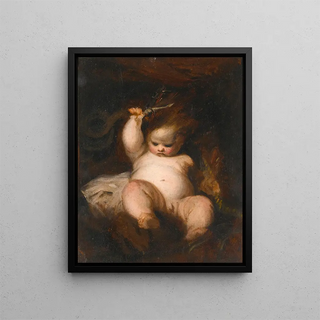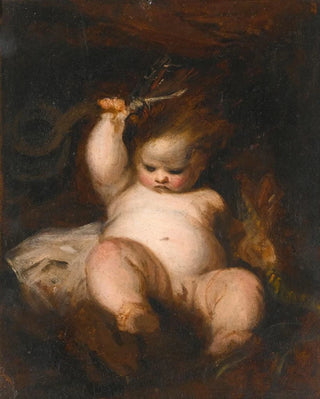Art print | L'enfant Hercule - Sir Joshua Reynolds


View from behind

Frame (optional)
In the vast universe of art, some works transcend time and culture, captivating souls with their beauty and depth. "The Child Hercules" by Sir Joshua Reynolds fits into this tradition of artistic excellence. Through this piece, the viewer is invited to immerse themselves in a world where mythology and childhood meet, where strength and tenderness intertwine. This painting, emblematic of 18th-century British portraiture, evokes not only the power of the mythological hero Hercules but also the tenderness of a child in full bloom. The magic of this artwork lies in its ability to tell a story, evoke emotions, and celebrate the beauty of innocence.
Style and uniqueness of the work
Reynolds' style is distinguished by a remarkable mastery of light and color. In "The Child Hercules," the artist manages to capture the freshness of childhood while incorporating elements of heroic grandeur. The delicate nuances of the flesh, the subtle play of shadows and highlights, as well as the richness of drapery, create an atmosphere that is both lively and timeless. The child, depicted with already defined musculature, embodies a promise of strength and courage, while maintaining palpable innocence. This blend of power and vulnerability, present in the gaze and posture of the child, is a characteristic that makes this work unique. The composition, carefully balanced, guides the viewer's eye toward the expressive face of the child, revealing a rare psychological depth for a portrait.
The artist and his influence
Sir Joshua Reynolds, an iconic figure of British painting, knew how to mark his era with an innovative style and a humanist approach to portraiture. As the first president of the Royal Academy of Arts, he played a decisive role in the evolution of art in England. Reynolds drew inspiration from the old masters while developing a distinctive aesthetic focused on the representation of ideal beauty and moral values. His influence extends well beyond his time, inspiring many artists through the centuries. "The Child Hercules" bears witness to his ability to combine impeccable technique with sincere emotion, a characteristic

Matte finish

View from behind

Frame (optional)
In the vast universe of art, some works transcend time and culture, captivating souls with their beauty and depth. "The Child Hercules" by Sir Joshua Reynolds fits into this tradition of artistic excellence. Through this piece, the viewer is invited to immerse themselves in a world where mythology and childhood meet, where strength and tenderness intertwine. This painting, emblematic of 18th-century British portraiture, evokes not only the power of the mythological hero Hercules but also the tenderness of a child in full bloom. The magic of this artwork lies in its ability to tell a story, evoke emotions, and celebrate the beauty of innocence.
Style and uniqueness of the work
Reynolds' style is distinguished by a remarkable mastery of light and color. In "The Child Hercules," the artist manages to capture the freshness of childhood while incorporating elements of heroic grandeur. The delicate nuances of the flesh, the subtle play of shadows and highlights, as well as the richness of drapery, create an atmosphere that is both lively and timeless. The child, depicted with already defined musculature, embodies a promise of strength and courage, while maintaining palpable innocence. This blend of power and vulnerability, present in the gaze and posture of the child, is a characteristic that makes this work unique. The composition, carefully balanced, guides the viewer's eye toward the expressive face of the child, revealing a rare psychological depth for a portrait.
The artist and his influence
Sir Joshua Reynolds, an iconic figure of British painting, knew how to mark his era with an innovative style and a humanist approach to portraiture. As the first president of the Royal Academy of Arts, he played a decisive role in the evolution of art in England. Reynolds drew inspiration from the old masters while developing a distinctive aesthetic focused on the representation of ideal beauty and moral values. His influence extends well beyond his time, inspiring many artists through the centuries. "The Child Hercules" bears witness to his ability to combine impeccable technique with sincere emotion, a characteristic






